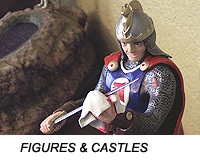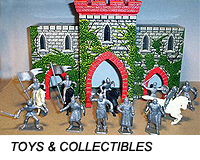The Hausser firm was founded in 1904 by Christian Hausser and his sons Otto and Max. The factory was situated in Ludwigsburg near Stuttgart. They made all kind of toys and from 1912 also toysoldiers. These were made of ‘Masse’. Although there were all kind of figures, the toy soldiers were the most popular. The numbers were enormous: In 1938 only they made 3 million toy soldiers. In the most productive time Hausser had 1400 employees.
Plastic
In 1939 Hausser starts to experiment with plastic. It will last until 1955 before the first polysterol plastic figures are introduced and sold. From then on it’s goes rapidly onwards. Many figures with all kinds of themes are made. In 1970 the first soft-plastic figures are made. They will never have the success of the hard plastic Elastolin figures.
Decline and the end.
From 1970 profits of Hausser are rapidly going down. All figures are hand-painted so costs become very high. The soft plastic figures of for instance Timpo Toys are much cheaper. Hausser can not cope with this and has to stop production in 1983.
Preiser
De Hausser Mouls were bought bij the Preisser firm. They are well known for het small scale scenery figures. Until today they have some figures in their catalogue. Canons and other equipment are no longer made. Although under the socle of these new figures you still can read Elastolin this are mostly Preiser figures.
THE NAME ELASTOLIN
De figures got the brand name Elastolin. This name is now used for all kinds of ‘Masse’ figures. The name Elastolin stands also for the hard plastic figures from Hausser. You can read Elastolin on all the socles of the plastic figures. The name of Hausser can be found at all the plastic canons and siege equipment.
MASSE
Masse is a material of mainly sawdust and glue. The figures were pressed in a mould and hold together by iron wire. Hausser made these Masse figures until the 60’s of the last century. There are a lot of collectors of these figures.
RANGES
Hausser made figures of 4, 51/2, 7, 10 en 14 cm. The first plastic figures were made with the old ‘Masse’ moulds. These moulds were of iron and quickly became bad. Later figures were made with steel moulds. From then on Hausser produces only 4 and 7 cm figures.
PAINTING
There are three or four kinds of painted figures, canons and siege equipment.
Variation 1
The firts plastic figures were made of ivory white plastic. First the body parts were coloured. Then the clothes and weapons were painted. After this was finished the paint was slightly washed off. In the deeper parts of the figures the paint was still there. In this way you got ‘washed’ or in German Wachser figures. These ‘Wachser’* are very rare.
*WachserThese first plastic painted figures are very rare.
The figures that are made of the first ‘masse’ moulds and wachser that are made in the later steel moulds
Variation 2
The next group of figures were first also ivory white and some years later pink or brown. The body parts were now much thicker painted than variation 1 and they were no longer ‘washed’. The clothes were sometimes washed and there were shadow parts painted. This was done until 1965.
Variation 3
All the figures of this variation were made of plastic with a skin colour plastic. The body parts were no longer painted which was much cheaper. These figures were made until the end of the firm Hausser.
New Preiser figure
These are again made of white plastic. Preiser brings a small variation of the old Elastolin figures. They are sold in small boxes under the name of Preiser. You can find them in the better toyshops.
RANGES
Scale
The plastic Elastolin figures were made in different measures:
4 cm (schale 1:45)
5,5 cm
7 cm (schale 1:25)
10 cm
14 cm
From 1960 were 4 cm figures made. These were exact copies of the 7 cm series.
The other scales were used for other figures like special uniforms, figures in local costumes and figures of fairy tales.
Outside Germany
In Austria Hausser had another firm: Tipple Topple. Here were figures made under license They are mostly a little simply painted. They stand on olive green socles with the name beneath ‘Tipple Topple’ or ‘Elastolin in Austria’
De firm Ougen in France imported great quantities unpainted figures. They were painted in France and sold under the name Ougen
SOCLES PUT IN IMAGE OF SOCKETS
The first plastic figures had a dark green socle. Beneath you can read a J and the brandname Elastolin. The later socles did not have this J. They differ in colour. Most heave different kind of green colours. The pearl shell socle is very rare and much looked for.
All Elastolin figures stands on plastic socles. Just like as there are painting variants there are different socles. The shape has never been changed, only the colours.
You can recognize the later Preiser Socle immediately. In all the Hausser socles you can find a little round stansed hole. Preiser socles never have this small hole.

SUCCESSORS
Preiser still offers a small series of painted 7 cm Elastolin figures. Also the firm Barthel offers Elastolin, also newly made figures.
There are some new (German) firms who offer figures that look similar to the old Elastolin figures. They claim to work in the tradition of Hausser.
Germania Figuren has its own series of 4 and 7 cm figures. From Alexander the Great towards modern personalities.
An other new firm is Janetzki-arts. They also have an own line of figures. They are specialized in Prince Valliant.
PREISER
Preiser took over a lot of activities of Hausser in 1981.
First it seemed that the whole range would continue. Almost all the figures were mentioned in the price list. There were even some new figures in the Elastolin style made by Preiser. Especially the Prussian infantry is very good.
But problems started soon. Production costs for the siege equipment were to high. They stood in the Preiser catalogues but came never into production. More and more traditional figures disappeared from the price list.
Especially in the better German toy stores you can find some Elastolin figures made by Preiser. They are sold in small boxes and are still hand painted. You can download the Preiser catalogue -HERE-.
PRINCE VALIANT
These figures are based on the comics by Harold Foster. In Germany called Prinz Eisenherz.
You can still buy the comics, but especially in the late 50’s they were very popular. Historically the comics are not very correct. Late medieval knights fight against Romans, Huns and Vikings. Anyone who reads the comics of prince Valliant will find different Elastolin figures. Not only the prince and his friends but also Huns and Vikings.
NORMANS
Maybe the most beautiful figures from the whole Elastolin range. Rearing horses, in full gallop, drawn swords. A noble woman completes the series. Knights as they should be. The historical periods are a little mixed up but the figures are made with care and with a lot of detail. This series was started by Hausser in 1955.
VIKINGS
The figures of the Elastolin Vikings can maybe seen in the Nibelungen of Wagner.
Historically they are realistic although all the wings on their helmets are maybe a little too much. But they give the impression of a viking we read about in books and comics. And that is ofcourse were it is all about.
ROMANS
The Elastolin Romans are made with al lot of fantasy. They were very colourfull and not historicalle accurate The roman legions that conquered the world looked a bit different.
HUNS
Huns are rare as toy soldiers. These figures of Elastolin are very pretty and historically almost correct. Especially the eastern parts of Europe suffered a lot of the Hun hordes in the fourth century. They often are mentioned in legends, for instance in the Nibelungen.
WESTERN
Hausser made already al lot of Indians and cowboys in Masse before they started with the plastic range
KARL MAY
In the early fifties Hausser got the exclusive dealing right to make figures from the books of the in Europe well known author Karl May. Most famous characters of his books were Winnetou and Old Shatterhand.
After Winnetou died in one of the books the stories play in the middle east. Old Shatterhand becomes Kara Ben Nemsi. Especially in Germany the adventures of Winnetou were very popular in the fifties and early sixties. There were some movies and Elastolin made a lot ‘Karl May’ figures.
CASTLES & FORTIFICATIONS
There were different castles in the last catalogue. Until the late sixties almost all the castles and (western) fortifications were made of masse or wood. In the seventies the castles were made of plastic. Most castles were for the 4 cm range. There were some special figures for the forge.
|








